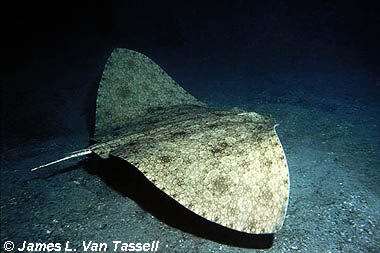
Gymnura altavela
These broad, flat diamond-shaped rays are much wider than they are long, with a short tail that has one or more serrated spine at the base. They are generally dark brown, sometimes with pale-rimmed dark spots or blotches. They have been reported at almost 13 feet wide, but average around 7 feet wide.
They prefer sandy or muddy bottoms of brackish and coastal areas, where they disguise themselves in the sand and hunt crustaceans, mollusks, and small fish.
Order – Myliobatiformes
Family – Gymnuridae
Genus – Gymnura
Species – altavela
Common Names
Common English names for this species include spiny butterfly ray, butterfly ray, and the giant butterfly ray. Other names include aeroplanke (Albanian), altavela (Italian), avejão (Portuguese), bâsternâk (Arabic), doornvlinderrog (Dutch), farfett (Maltese), isoperhosrausku (Finnish), kazikkuyruk baligi (Turkish), khop (Wolof), mariposa (Spanish), marmorerad fjärilsrocka (Swedish), motýlovec trnitý (Czech), pastenague ailée (French), peitschenrochen (German), pilrokke (Norwegian), platyselacho (Greek), ptaszyca (Polish), raia-borboleta (Portugese), raya mariposa (Spanish), and stor sommerfuglerokke (Danish).
Importance to Humans
These rays are of minor commercial importance and in some places are listed as a game species.
Danger to Humans
The spiny butterfly ray is harmless to humans as it is not aggressive but if stepped on, it will utilize its spine as a defense. The wound will most likely be painful but not lethal.
Conservation
> Check the status of the spiny butterfly ray at the IUCN website.
The IUCN is a global union of states, governmental agencies, and non-governmental organizations in a partnership that assesses the conservation status of species.
Geographical Distribution
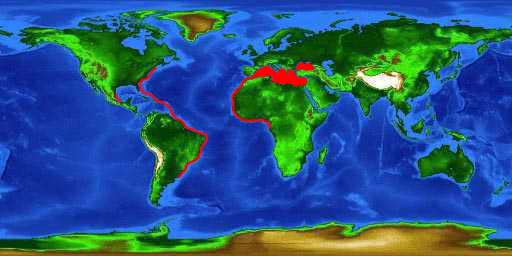
The spiny butterfly ray is found in the western and eastern Atlantic Ocean. In the western Atlantic it occurs from southern New England to Brazil. It is rarely recorded in the Gulf of Mexico. In the eastern Atlantic it occurs from Portugal to Ambriz, Angola (including the Mediterranean, Black Sea, and the Madeira and Canary islands).
Habitat
The spiny butterfly ray is a demersel species that prefers brackish and coastal waters and is known to occur in depths ranging from five to 100 meters. This ray generally occurs over sand and mud bottoms.
Biology
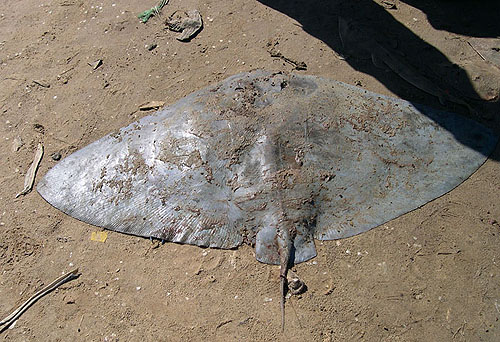
Distinctive Features
This is a broad, diamond-shaped ray with a short tail armed with a dorsal spine. This ray has a protruding snout. The front edges of the disk are concave. The tail has low dorsal and ventral fin folds. The spiny butterfly ray has a slender tentacular structure on the inner posterior margin of each spiracle. These structures are lacking in the smooth butterfly ray (G. micrura). G. altavela has a more obtuse anterior angle than G. micrura. The keeled shape of the upper surface of the tail of G. altavela separates it from G. hiruno.
Coloration
The spiny butterfly ray is typically dark brown dorsally with a grayish or reddish cast or coffee brown shading to cinnamon at the margins sometimes with pale rimmed ocular spots. They have also been known to be dorsally brown with small darker spots or light spots and blotches (usually marbled) and white ventrally. The tail of small specimens is marked with pale crossbars, which usually fade over time.
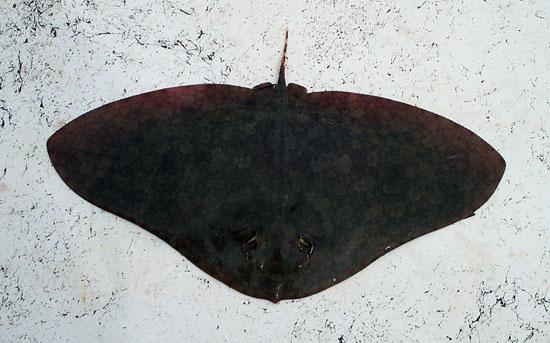
Dentition
The upper jaw generally has 98 to 138 teeth with each tooth having a high conical cusps. The lower jaw generally has 78 to 110 teeth. Teeth tend to get larger as the ray itself grows but remain as sharp throughout development to adulthood. In both the upper and lower jaw there are about 10 to 12 rows of functional teeth and each dental band takes up about 70% the width of the jaw.
Denticles
The skin is relatively smooth in small or medium specimens but is described as rough in the larger specimens.
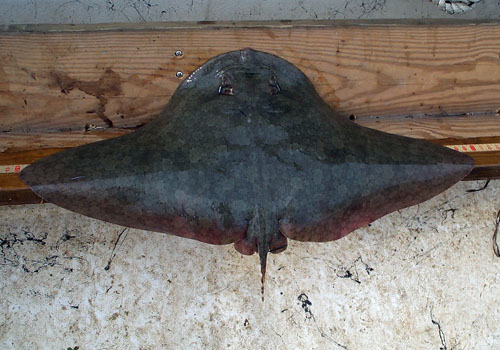
Size, Age, and Growth
The maximum recorded disk width of the species is 13.1 feet (4.0 m) and the maximum published weight is 132 pounds (60.0 kg). The maximum reported total length is 4.6 feet (1.4 m). Off the Tunisian coast of northern Africa females are larger than males with the size at first maturity of males estimated at 2.6 feet (0.78 m) disc width.
Food Habits
Feeds on fishes, crustaceans, mollusks and plankton.
Reproduction
G. altavela is an aplacental viviparous species (ovoviviparous), with two functional uteri. Gestation likely lasts four to nine months. One reproductive cycle occurs per year. Average disc width and weight of fully developed embryos have been reported as 11.6 inches (29.4 cm) and 2.2 pounds (269.3 g) in Tunisian waters. Fecundity ranges from two to six embryos per litter with an average of approximately four in western Atlantic waters. Embryos are symmetrically distributed in each uterus.
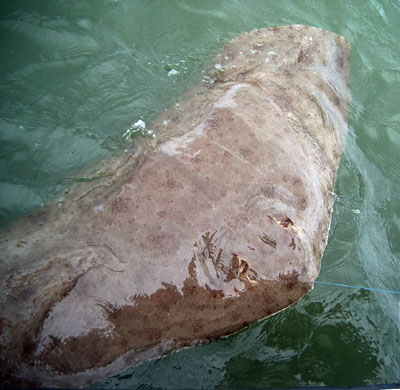
Predators
Potential predators include larger fishes and marine mammals. Great hammerhead sharks likely are predators of gymnurid rays.
Parasites
A three-year study done in 1995 collected seven spiny butterfly rays and tested them for parasites. A phyllobothriid cestode new to science was found in the spiral intestine of all host specimens. In addition, Heteronchocotyle gymnurae, a gill parasite, is often seen in these rays.
Taxonomy
Linnaeus first described the spiny butterfly ray in 1758. The genus Gymnura of the currently accepted scientific name is derived from the Greek word gymnos meaning naked. Synonyms for Gymnura altavela include Pteroplatea altavela, Raja altavela, Dasyatis altavela, Raja maclura, Dasyatis canariensis, Pteroplatea canariensis, Pteroplata valenciennii, Pteroplatea binotata, and Pteroplatea vaillantii.
Prepared by: Christina Conrath and Rebecca Scarbrough